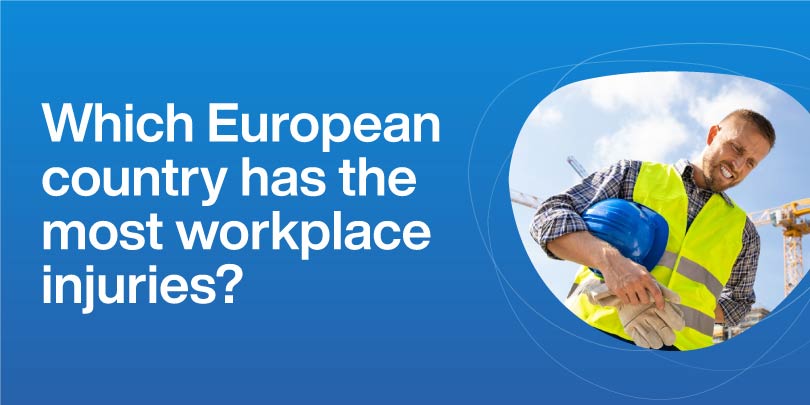
Corinne McKenna LLB
Legal writer
How Much Could You Claim?
Does your claim qualify? Get free, no obligation advice!

Health and safety should be at the forefront of everyone’s minds, particularly when it comes to the workplace. Although guidelines across every business will vary, across Europe there are a variety of different approaches taken when it comes to keeping employees safe and well. That being said, accidents are unfortunately inevitable, with no workplace being able to guarantee 100% safety.
Claims.co.uk analysed data from Eurostat to find out in which European countries employees are most likely to fall victim to a workplace injury. We’ll include tips on how to avoid an injury at work, as well as advice on what to do if you’re injured at work in the UK.
The European country with the highest number of workplace injuries per 100,000 people is Portugal, with 2,848 experiencing an injury at work in the last year. Portugal also comes out on top for the number of “superficial” injuries, meaning minor injuries that don’t cause serious damage. They also have the highest level of “traumatic amputations”, which refers to loss of a limb. Employees also experience high levels of dislocation, sprain and strain injuries, coming in third place.
Second place goes to France, which at 2,822 is just 26 fewer injured workers per 100,000 than Portugal. Unlike Portugal, however, France doesn’t have the highest levels of any injury in particular.
Spain comes in third, with 2,491 injured workers per 100,000 people, which is 331 fewer than neighbouring France in second. Of these injuries, Spain has the most dislocation, sprain and strain injuries of all European countries. We found that 1,162 Spaniards endure this injury per year, which is 165 more than Luxembourg in second.
Next is Luxembourg, which has a similar level of injury to Spain. At 2,482, it is only 10 people short of making the top three. However, Luxembourg ranks first for bone fracture injuries, with 337 workers per 100,000 people sustaining a fracture whilst at work each year.
Rounding off the top five European countries for injuries at work is Germany, where 2,133 out of 100,000 employees are injured per year. Despite Germany only ranking within the top three for bone fractures, its high score overall is due to the fact that it does make at least the top ten for every category, with the majority of these injuries being classed as “wounds and superficial injuries”.
The UK fares well overall, coming in 19th place out of all 30 European countries analysed, with 683 injuries at work per 100,000 people. Just ahead of the UK is the Czech Republic, which has 821 injuries per 100,000 people, and just behind the UK is neighbouring Ireland with 592.
The number of injuries in the UK is a whopping 2,165 less than Portugal in first place, and 627 more than Romania, which is listed as having the least number of injuries – just 56 per 100,000 people!
Not only does Portugal rank the highest for workplace injuries overall, but it also comes out on top for wounds and superficial injuries – 1,284 injuries per 100,000 people. This type of injury accounts for almost half of their total injury score, making it Portugal’s most common type of injury.
Though this isn’t the most common injury type for Luxembourg, which comes in second place for this injury type, it is the most common injury type for Slovenia in third, and Austria in fifth. One place ahead of Austria for this type of injury, however, is Spain. Despite Spain being ahead of Austria for this injury type, most workplace injuries in Spain come under the category of “dislocation, sprain and strain”.
The UK yet again fares relatively well for the wounds and superficial injuries category, coming in 18th out of 30 European countries, with 176 injuries per 100,000 workers. While this is far less than Portugal or Luxembourg, it is substantially more than Romania, which has the lowest rate of this type of injury, at just 17.
Bone fractures appear to be less common than superficial injuries and wounds. Portugal doesn’t feature in the top five for this category, with Luxembourg taking the top spot instead, with 337 injuries per 100,000 people. Denmark comes in second (274 per 100,000 people), closely followed by Germany, Austria and Estonia, with similar injury rates of 266, 251 and 246, respectively.
For bone fractures, the UK is a little higher in the rankings, with 160 injuries per 100,000 people. This leaves the UK in 11th spot, just over one-third of the way down the list. Interestingly, with the lowest rate of fractures being in Sweden (13 per 100,000 people), this means that the UK has over 12 times the amount of fractures as Sweden, and Luxembourg has over 25 times more!
Along with wounds and superficial injuries, dislocation, sprain and strain injuries are the most common injury types overall. Spain has the most injuries in this category, with 1,162 workers out of 100,000 sustaining an injury of this kind. Second, third and fourth place goes to Luxembourg, Portugal and Denmark, with 997, 986 and 761 injuries per 100,000 people, respectively. Fifth belongs to France (520), which has less than half the amount of dislocation, sprain and strain injuries when compared to neighbouring Spain.
The UK falls in the middle of the list for this type of injury, in 16th place, with 218 injuries of this kind per 100,000 people. Yet again, Romania comes in last, with just five injuries occurring per 100,000 workers. This is over 200 times less than Spain which is at the top, and 20 times less than more middling countries.
Thankfully, the most serious type of injury is also the least common. Traumatic amputations – or loss of body parts – happen at a far lower rate than other injury types. In fact, for the vast majority of countries, this happens to less than 10 times per 100,000 workers. However, this can still happen when machinery is ill-maintained or used incorrectly.
Portugal comes in first place for this injury type, with 24 injuries per 100,000 people. They are followed closely behind by Estonia, with 22. The Netherlands in third place sees a drop of almost half, with 12 instances of traumatic amputation, followed by Croatia with 11 and Austria with 10.
The UK has just three instances of traumatic amputation per 100,000 workers, with the lowest instances of this occurring being in Denmark and Switzerland, with 0.4.
Although workplace injuries are bound to happen from time to time, following these recommendations can help significantly reduce the risk of sustaining injuries at work:
According to our analysis of Eurostat data, the top three industries in the UK in which workers are most likely to be fatally injured are as follows:
While non-fatal injuries are most often sustained by those working in the following industries:
There are a set of recommended steps to take if you or a colleague is injured at work:
1) Claims.co.uk analysed Eurostat’s 2019 data (the latest data available) on accidents in the workplace in 30 European countries.
2) Iceland was excluded from the research due to no available data.
3) Albania, Andorra, Armenia, Azerbaijan, Belarus, Bosnia and Herzegovina, Georgia, Kazakhstan, Liechtenstein, Moldova, Monaco, Montenegro, North Macedonia, Russia, San Marino, Serbia, Turkey, and Ukraine were also excluded, as Eurostat does not provide data coverage for these selected European countries.
4) Claims.co.uk extracted the overall accidents at work figures per European country and also a breakdown of the figures by injury type: wounds and superficial injuries, bone fractures, dislocations and sprains and strains and traumatic amputations (loss of body parts).
5) All workplace injury figures extracted from Eurostat were non-fatal injuries, i.e., those workers who have missed four or more days due to their workplace injury.
6) Thereafter, Claims.co.uk utilised population data from the World Bank and percentage (%) of working-age population data from the Organisation for Economic Co-operation and Development (OECD) to establish the estimated number of people in each of the 30 analysed European countries that are of working age.
7) Claims.co.uk then used the percentage (%) employment rate figures from OECD to calculate the number of working-aged people in employment.
8) OECD did not have 2019 employment rate figures for Bulgaria, Croatia, Cyprus, Malta, and Romania – 2019 employment rate figures for these respective European countries were sourced from Tradingeconomics.com instead.
9) The 2019 population, percentage (%) of working-age population and percentage (%) employment rate figures were used to make it a fair assessment against the 2019 accidents in the workplace figures. Doing so also avoided the employment fluctuations caused by Covid-19.
10) Utilising the total accidents in the workplace figures and the total people in work figures, Claims.co.uk calculated the rate of workplace injuries per 100,000 employed persons.
11) The 30 European countries were then ranked from highest to lowest based on the workplace injuries per 100,000 employed persons.
12) The 3.4 million (3,467,132) non-fatal workplace injuries statistic from Eurostat is in reference to the total non-fatal injuries suffered by workers in 30 European countries (all European countries which are shown on the data/results table) in 2019 (with the exemption of the United Kingdom).
13) All datasets used for the United Kingdom were from 2018, as 2019 data was not available for the United Kingdom.
14) All data for the research was collated on Wednesday 16th February 2022 and is correct as of then but is subject to change.
https://www.concentra.com/resource-center/articles/10-tips-to-prevent-workplace-injuries/
https://advancedct.com/the-best-tips-for-prevention-of-accidents-in-the-workplace/
https://www.iii.org/article/steps-to-reduce-workplace-injuries
https://www.lawyer-monthly.com/2020/09/10-tips-on-how-to-prevent-or-minimise-workplace-accidents/
https://www.virtual-college.co.uk/resources/manual-handling-weight-limits#:~:text=What%20is%20the%20Maximum%20Weight,of%20the%20person%20handling%20it.
https://www.hse.gov.uk/firstaid/
https://www.spillcontrolcentre.co.uk/news/2015/12/spills-in-the-workplace/
https://ec.europa.eu/eurostat/statistics-explained/index.php?title=Accidents_at_work_-_statistics_by_economic_activity
https://www.nimblefins.co.uk/business-insurance/employers-liability-insurance-uk/workplace-injury-statistics-uk
When you submit your details, you'll be in safe hands. Our partners are National Accident Helpline (a brand of National Accident Law, a firm of personal injury solicitors regulated by the Solicitors Regulation Authority). They are the UK's leading personal injury service. Their friendly legal services advisers will call you to talk about your claim and give you free, no-obligation advice. National Accident Law may pay us a marketing fee for our services.
By submitting your personal data, you agree for your details to be sent to National Accident Law so they can contact you to discuss your claim.
If you win your case, your solicitor's success fee will be taken from the compensation you are awarded - up to a maximum of 25%. Your solicitor will discuss any fees before starting your case.
Our experts